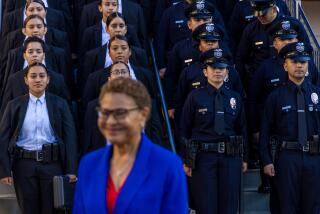Police Forces Seek Diversity : But Minorities Still Underrepresented in County Departments
- Share via
Lorenzo Glenn, a 24-year-old rookie police officer in Westminster, is unabashedly proud of his African-American and Japanese heritage. But that ethnic pride is put on hold when he steps inside the station house.
When he’s around his white colleagues, Glenn makes a point of trying to mix with the crowd. He doesn’t ask stupid questions. He doesn’t call attention to himself. He doesn’t even dress much differently than anyone else.
“I’m reluctant to wear my Malcolm X hat or my black T-shirts. They might think I’m some sort of revolutionary,” said Glenn, one of just three black officers at the 101-member Westminster Police Department. “I don’t feel comfortable doing that yet.”
For Glenn and other minority police officers in Orange County, trying to assimilate into a police department--an environment dominated by whites--often means discarding cultural ties. In some cases, it even means ignoring an occasional racial snub from some peer.
With the minority population in Orange County growing at a rapid rate, many local police departments have increased the ranks of Latinos, Asians and African-Americans. But minorities, who make up 35.5% of the county’s population, make up only 16.4% of officers on police departments in the county.
A survey last November showed that the 86 African-American officers make up 2.2% of sworn officers in the county’s police forces and the Sheriff’s Department.
Although bilingual Latinos are prized by recruiters, they too are rare, totaling 280 in the county. Santa Ana has the greatest percentage of Latino officers, who make up 24.8% of the department. But that pales in comparison to the city’s population, which is 65.2% Latino.
With such a relatively small representation, minority officers now on the force face unique pressures, grappling with subtle displays of racism and the perception among some that their skin color was the credential that earned them their badge.
Interviews throughout Orange County indicated that most were too busy concentrating on the daily grind of police work to reflect on the role their ethnicity played in policing, but they said the race issue popped up occasionally.
Chief Manuel Ortega of the Placentia Police Department said minorities usually have to work twice as hard to prove themselves.
“Any minority, whatever the race, had to work extra hard at gaining acceptance,” Ortega said.
But Eric Nunez, a 29-year-old Latino officer at the La Palma Police Department, insists that race is a secondary issue.
“No matter what ethnicity you are, people see you as a cop first,” said Nunez, one of three Latino officers at La Palma.
“I don’t have that image of myself as a Latino officer. This job isn’t a white man’s job. I’m comfortable with who I am and what I do. I don’t live by other peoples’ philosophy or their rules.”
Nunez said he has never encountered any form of racism in his department or while he’s been on duty.
“It’s almost as if I’m not Latino,” Nunez said one recent night while patrolling the streets of La Palma. “If officers have prejudices, they don’t show it. They don’t bring it to work. I don’t concern myself with it that way. I don’t compensate or overcompensate for it to affect the way I do my policing.”
Art Delgado, director of Project AERO, a 2-year-old program that prepares minority officers for entry into law enforcement training at Golden West Academy, said he teaches trainees self-esteem and confidence.
“We tell them they should not go into the force thinking they were hired because they are a minority,” Delgado said. “We tell them not to ostracize their race, but to treat everyone the same. You have to know that you were hired because you met and exceeded the standards.”
Still, Orange County police departments are making a push to hire officers representing a wider array of races.
“It’s our responsibility to mirror the community,” Santa Ana Police Chief Paul M. Walters said. “About 65% of our population is Latino, so we want to reflect that.”
As yet, Santa Ana and most other communities have only made a dent in the numbers. There are about 100 Latinos among 400 officers at the department, well below community population ratios.
Nunez, an AERO graduate, is more concerned with tending to business than pondering how his Latino heritage might have played a role in his getting hired.
“My biggest worry is repeating mistakes and embarrassing the department,” Nunez said. “It’s more a concern than a worry. . . . I’m still trying to improve myself as a rookie.”
While some minority officers say they are able to shrug off even the most subtle racial slur, there are times when it cannot be ignored.
“I hate being called boy ,” Glenn said of the word used on occasion by a few of his colleagues. “Every black person knows what it means. Not lots of people do it, but it happens. First you try to justify their actions. . . . You say to yourself, this person doesn’t know me. You try not to take it personally, and after a while, it really starts to build up.
“But most of them (fellow officers) like me. I think they see me as a new cop first and not a black cop.”
Glenn’s white colleagues may have forgotten his race entirely when an incident occurred a few months ago.
He was on mall duty with a partner when they saw a group of young black men hanging out at the mall. Members of the group were dressed in T-shirts and jeans.
Glenn’s partner turned to him and commented that members of the group were probably up to something. They should check it out to make sure nothing was amiss.
“I asked him why he said this. He said it was the way they were dressed,” Glenn recalled. “That upset me. He was feeding into a stereotype.”
In dealing with the public out on the beat, the question of race can also crop up as an issue.
“To me, racism is always there,” Glenn said. “Some people are going to judge you on your skin color alone. That’s just a fact, the way it is.”
When things really start to build up, Glenn confides in a friend, Fred Small, another rookie at the department who is also black.
There was, for instance, the time Glenn headed out to a domestic dispute involving a man who hit his wife. But when he arrived, the woman acted as though she would rather deal with someone else.
“She’s didn’t ignore me. But she was not cooperative,” Glenn recalled, noting that when a white officer arrived on the scene to back him up, “she started talking to him and completely ignored me.”
It has been a recurring theme on other nights, at other crime scenes, Glenn said.
“Sometimes, its not just ignoring you,” Glenn said. “They’ll speak to (a white officer) in a different tone than they speak to me.
“I just let (the white officer) handle it and walk away,” he said.
“It’s easier than getting into an argument. Those things can get ugly when emotions are involved. . . . A police officer has to be professional.”
Ethnic, Racial Parity Falls Short
How percentage of Latinos, Asians and blacks in Orange County’s police forces and Sheriff’s Department compare with percentages in the population.
LATINOS ASIANS BLACKS % in O.C. police forces 11.2% 2.4% 2.2% % in O.C. population 23% 10% 1.6%
Source: Individual police departments, U.S. Census Bureau
More to Read
Sign up for Essential California
The most important California stories and recommendations in your inbox every morning.
You may occasionally receive promotional content from the Los Angeles Times.










